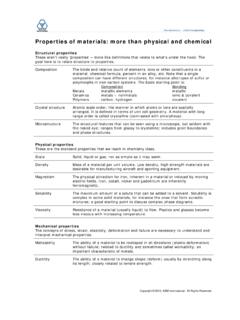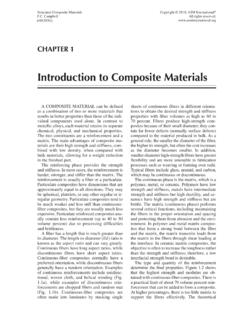Transcription of Chapter 1 Introduction to Chemical Vapor Deposition (CVD)
1 2001 ASM International. All Rights Reserved. Chemical Vapor Deposition (#06682G). Chapter 1. Introduction to Chemical Vapor Deposition (CVD). J. R. Creighton and P. Ho Sandia National Laboratories Box 5800, MS0601. Albuquerque, NM 87185-0601. Introduction The handbook by Pierson3 contains a very useful discussion of specific materials and CVD. Chemical Vapor Deposition (CVD) is a processes, as does the book by The widely used materials-processing technology. books by Hitchman and Jensen, 5 and by The majority of its applications involve applying Sherman, 6 concentrate more on silicon solid thin- film coatings to surfaces, but it is also microelectronics applications, while the books used to produce high-purity bulk materials and by Stringfellow7 and by Jones and O'Brien8.
2 Powders, as well as fabricating composite concentrate on compound semiconductor materials via infiltration techniques. It has been applications. The book by Kodas and Hampden- used to deposit a very wide range of materials. Smith9 and the series of proceedings volumes, As indicated by the shaded boxes in Figure 1, represented by Sandhu et focus on CVD of the majority of the elements in the periodic table metals. A separate series of books on CVD are have been deposited by CVD techniques, some the proceedings of the International Conferences in the form of the pure element, but more often on CVD held every two to three years since circa combined to form compounds.
3 1967, primarily sponsored by the Electro- CVD has an extensive literature, including Chemical Society. These provide useful a number of other books on the subject. The snapshots of the field at various times,11-13 are classic book by Powell, Oxley and Blocher1 a few of the more recent volumes in this series. covers much of the earlier work up to the mid Books by Vossen and Kern14 and Smith,15 cover 1960s, while a bibliography by Hawkins2 lists CVD as parts of their larger treatments of thin papers in CVD for the 1960-1980 time period. film Deposition . PERIODIC TABLE 2. IA IIA IIIA IVA VA VIA VIIA VIII IB IIB IIIB IV VA VIB VIIB O.
4 1 2. H He 3 4 5 6 7 8 9 10. Li Be B C N O F Ne Creighton and Ho 11 12 13 14 15 16 17 18. Na Mg Al Si P S CI Ar Chemical Vapor Deposition (#06682G). 19 20 21 22 23 24 25 26 27 28 29 30 31 32 33 34 35 36. K Ca Sc Ti V Cr Mn Fe Co Ni Cu Zn Ga Ge As Se Br Kr 2001 ASM International. All Rights Reserved. 37 38 39 40 41 42 43 44 45 46 47 48 49 50 51 52 53 54. Rb Sr Y Zr Nb Mo Tc Ru Rh Pd Ag Cd In Sn Sb Te I Xe (99) 55 56 57 72 73 74 75 76 77 78 79 80 81 82 83 84 85 86. Cs Ba La Hf Ta W Re Os Ir Pt Au Hg TI Pb Bi Po At Rn (210) (210) (222). 87 88 89. Fr Ra Ac (223) (226) 57 58 59 60 61 62 63 64 65 66 67 68 69 70 71.
5 LANTHANIDES La Ce Pr Nd Pm Sm Eu Gd Tb Dy Ho Er Tm Yb Lu (145) 89 90 91 92 93 94 95 96 97 98 99 100 101 102 103. ACTINIDES Ac Th Pa U Np Pu Am Cm Bk Cf Es Fm Md No Lr (244) (243) (247) (247) (251) (252) (257) (256) (259) (257). Fig. 1: Periodic table, where shaded boxes indicate elements that have been deposited using CVD. 2001 ASM International. All Rights Reserved. Chemical Vapor Deposition (#06682G). Introduction to Chemical Vapor Deposition 3. In its simplest incarnation, CVD involves surface to be coated and the source. Another flowing a precursor gas or gases into a chamber advantage of CVD is that, in addition to the wide containing one or more heated objects to be variety of materials that can be deposited, they coated.
6 Chemical reactions occur on and near can be deposited with very high purity. This the hot surfaces, resulting in the Deposition of a results from the relative ease with which thin film on the surface. This is accompanied by impurities are removed from gaseous precursors the production of Chemical by-products that are using distillation techniques. Other advantages exhausted out of the chamber along with include relatively high Deposition rates, and the unreacted precursor gases. As would be expected fact that CVD often doesn't require as high a with the large variety of materials deposited and vacuum as PVD processes.
7 The wide range of applications, there are many CVD also has a number of disadvantages. variants of CVD. It is done in hot-wall reactors One of the primary disadvantages lies in the and cold-wall reactors, at sub-torr total pressures properties of the precursors. Ideally, the to above-atmospheric pressures, with and precursors need to be volatile at near-room without carrier gases, and at temperatures temperatures. This is non-trivial for a number typically ranging from 200-1600 C. There are of elements in the periodic table, although the also a variety of enhanced CVD processes, use of metal-organic precursors has eased this which involve the use of plasmas, ions, photons, situation.
8 CVD precursors can also be highly lasers, hot filaments, or combustion reactions to toxic (Ni(CO)4), explosive (B2H6), or corrosive increase Deposition rates and/or lower Deposition (SiCl4). The byproducts of CVD reactions can temperatures. There are also many derivatives also be hazardous (CO, H2, or HF). Some of of the CVD terminology, such as metal-organic these precursors, especially the metal-organic Chemical Vapor Deposition (MOCVD)16,17 or, less precursors, can also be quite costly. The other commonly, organo-metallic Chemical Vapor major disadvantage is the fact that the films are Deposition (OMCVD), which are sometimes usually deposited at elevated temperatures.
9 This used to note the class of molecules used in the puts some restrictions on the kind of substrates Deposition process. Some practitioners chose to that can be coated. More importantly, it leads to differentiate epitaxial film Deposition from stresses in films deposited on materials with polycrystalline or amorphous film Deposition , different thermal expansion coefficients, which so they introduced a variety of terms that include can cause mechanical instabilities in the epitaxy in the acronym. Two of the more deposited films. common variants are organometallic Vapor phase CVD processes can be categorized epitaxy (OMVPE) 7 and metalorganic Vapor according to the type of: phase epitaxy (MOVPE)18 which are often used 1.
10 Application, in the compound semiconductor epitaxy 2. Process and reactor used, or 3. Precursor and Chemical reaction used. literature. The next three sections of this Chapter are CVD has a number of advantages as a method for depositing thin films. One of the arranged around such subdivisions. These primary advantages is that CVD films are sections are followed by a discussion of the generally quite conformal, , that the film fundamental processes underlying CVD, such thickness on the sidewalls of features is as mass transport, thermodynamics, and comparable to the thickness on the top.









